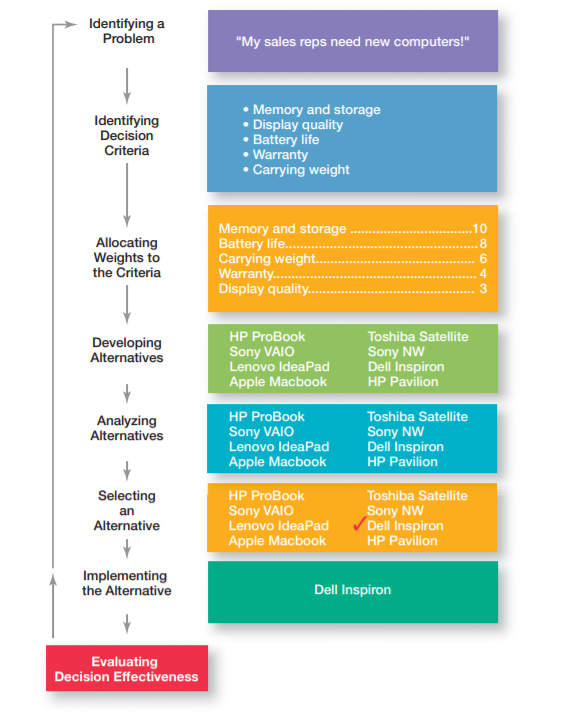Eight Steps in the Decision-Making Process
Step 1: Identifying a Problem
Your team is dysfunctional, your customers are leaving, or your plans are no longer relevant. Every decision starts with a problem, Decision making is an eight-step process that
begins with identifying a problem and ends with
evaluating the outcome of the decision. After
problem identification, managers must determine
the decision criteria that are relevant to solving the
problem.
Step 2: Identifying Decision Criteria
Once a manager has identified a problem, he or she must identify the decision criteria that
are important or relevant to resolving the problem. Every decision-maker has criteria guiding his or her decisions even if they’re not explicitly stated.
Step 3: Allocating Weights to the Criteria
If the relevant criteria aren’t equally important, the decision-maker must weigh the items
in order to give them the correct priority in the decision. How? A simple way is to give the
most important criterion a weight of 10 and then assign weights to the rest using that standard. Of course, you could use any number as the highest weight.
Step 4: Developing Alternatives
The fourth step in the decision-making process requires the decision-maker to list viable
alternatives that could resolve the problem. In this step, a decision-maker needs to be creative. And the alternatives are only listed, not evaluated just yet.
Step 5: Analyzing Alternatives
Once alternatives have been identified, a decision-maker must evaluate each one. Sometimes a decision-maker might be able to skip this step. If one alternative scores
highest on every criterion, you wouldn’t need to consider the weights because that alternative would already be the top choice. Or if the weights were all equal, you could evaluate
an alternative merely by summing up the assessed values for each one. (Look below Table) For example, the score for the HP ProBook would be 36, and the score for the
Sony NW would be 35.
Step 6: Selecting an Alternative
The sixth step in the decision-making process is choosing the best alternative or the one
that generated the highest total in Step 5. In our example (below table), Amanda would
choose the Dell Inspiron because it scored higher than all other alternatives (249 total).
Step 7: Implementing the Alternative
In step 7 in the decision-making process, you put the decision into action by conveying it
to those affected and getting their commitment to it. We know that if the people who must
implement a decision participate in the process, they’re more likely to support it than if you
just tell them what to do. Another thing managers may need to do during implementation is
reassess the environment for any changes, especially if it’s a long-term decision. Are the
criteria, alternatives, and choices still the best ones, or has the environment changed in such
a way that we need to reevaluate?
Step 8: Evaluating Decision Effectiveness
The last step in the decision-making process involves evaluating the outcome or result of the
decision to see whether the problem was resolved. If the evaluation shows that the problem
still exists, then the manager needs to assess what went wrong. Was the problem incorrectly
defined? Were errors made when evaluating alternatives? Was the right alternative selected
but poorly implemented? The answers might lead you to redo an earlier step or might even
require starting the whole process over.








Social Plugin